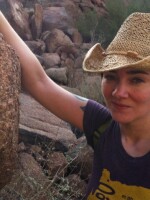The geology museum at the University of Wyoming recently re-opened after a long remodel. One of the features unveiled is a new fossil preparation lab. This lab offers U-W students, museum visitors, and the community a variety of opportunities to learn more about fossil prep. Wyoming Public Radio’s Chelsea Biondolillo has more.
CHELSEA BIONDOLILLO: The new prep lab on the main floor has large windows and several workstations with compressed air and electric tools wired from the ceiling. Around the stations, different fossils in various states of excavation allow visitors to see just how many steps are involved in the preparation process.
One by one, children and adults stop by to watch as Mitchell Lukens, a U-W student, works on part of an edmontosaurus. The pieces he’s working on may look like ordinary rocks, but they hold the spine of a late cretaceous dinosaur. Before he turns on the drill, Lukens closes a window near his workspace to keep million-year old dust from getting everywhere.
[Window closes, drill starts up]
MITCHELL LUKENS: “Right now I am working on simply taking off the matrix—the surrounding rock that is still present on the fossil—and then, using different preservatives to help conserve it for time.”
BIONDOLILLO: Lukens also uses a variety of brushes, dental picks, and sponges to carefully remove each layer of soil and sediment from the bones. He is one of a small handful of volunteers that museum manager Kelli Trujillo has trained, but she’s hoping to find more to help tackle their large inventory of unprocessed fossils.
KELLI TRUJILLO: “Most museums with a preparation lab rely on volunteers and community volunteers—we would really like to have volunteers in our lab because we’ve got a lot of fossils to work on and it’s all really interesting and we can train people, we just need them to be interested and to step up.”
BIONDOLILLO: And for Lukens, this hands-on opportunity is something he was eyeing long before the new lab was completed.
LUKENS: “I pestered Kelli for months in 2010 to try and start doing some preparation and fell in love with it very quickly, and I’ve worked with some very unique fossils to say the least.”
TRUJILLO: “And back at that time, we didn’t have the lab facilities to really train people and do this the right way. And now we do, and we’re looking to get more people in here.”
BIONDOLILLO: Trujillo has also trained an area school bus driver and other students to work in the lab so far. Lukens says for patient, detail-oriented individuals, fossil prep can be very rewarding.
LUKENS: “There’s nothing like uncovering something that hasn’t seen the light of day in 68 million years. The oldest I’ve personally worked with is 150 million years old, with stegosaurus and camarasaurus bones respectively from Montana and here in the state of Wyoming.”
BIONDOLILLO: And even if you don’t want to prep fossils, the lab still provides visitors with new insight into the process of fossil excavation and preparation. Trujillo wants the lab to serve as an educational tool for both volunteers and museum visitors. For this reason, she always has a variety of specimens on display, and one of the windows opens to the museum, so that visitors can chat with volunteers about what they are doing.
Kyle Bolenbaugh of Laramie has been visiting the museum regularly for several years and has enjoyed exploring the remodeled museum.
KYLE BOLENBAUGH: “This whole remodeling project has been fantastic. I’ve been here a number of times prior to the changes and then afterwards, it’s a regular stop on a cold day just to come in and look at it.”
BIONDOLILLO: He always makes sure to stop by the prep window to see if any new specimens are out and to watch the volunteers work the drills and brushes.
BOLENBAUGH: “Well, I think that being able to see this kind of science going on, is really a pretty cool thing.”
BIONDOLILLO: Bolenbaugh didn’t know the museum took volunteers – but thought doing the science would be pretty cool, too.
For Wyoming Public Radio, I’m Chelsea Biondolillo.



